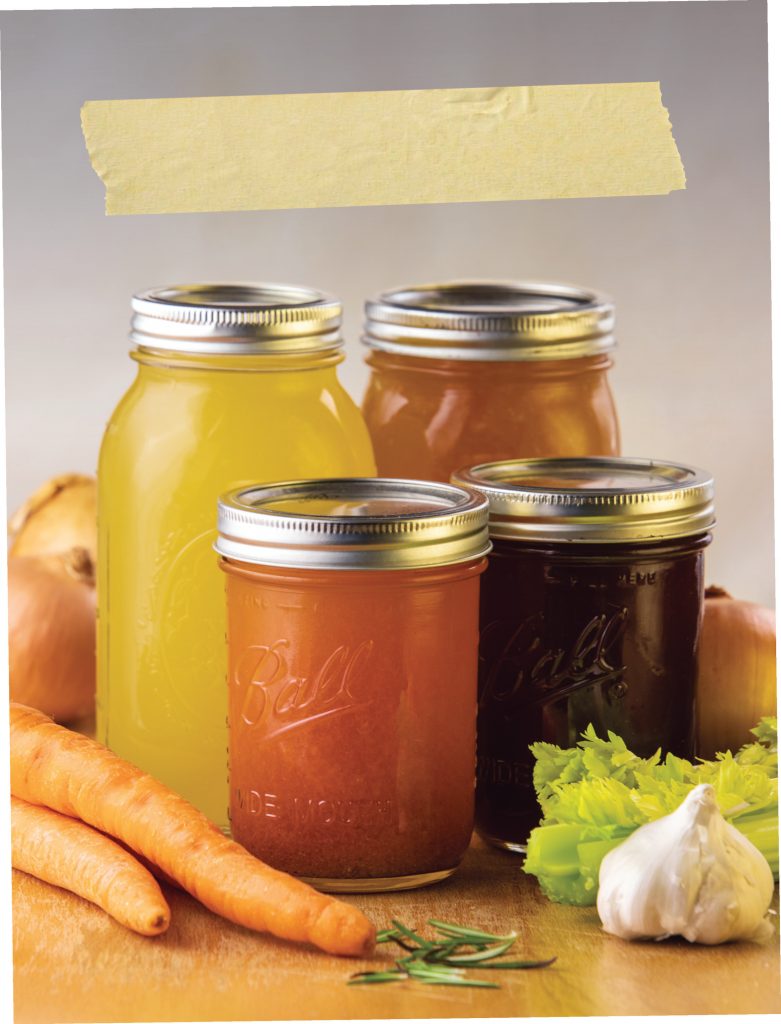Preparing homemade stock will add bountiful flavors to your recipes
Other than water, it’s hard to imagine anything more useful than stock, that delicious liquid made from the merger of many ingredients. It can be vegetarian or meat-based but is always a tasty solution to all the leftover, wholesome tidbits of vegetables and meats that might otherwise be discarded. Once stock is made, it can be stored to be used to improve almost any dish.
All-Day Beef Bone Stock
- 6 beef bones
- 2 celery stalks, cut in thirds
- 2 large garlic cloves, peeled and minced
- 1 onion, peeled and quartered
- 4 thyme sprigs
- 4 rosemary sprigs
- 4 peppercorns
- 1 bay leaf
- 2 tablespoons cider vinegar
- 2 teaspoons salt
- 4½ quarts water
- Place the bones in the bottom of a large (6-quart) slow cooker. Add the celery, garlic, onions, thyme, rosemary, peppercorns, bay leaf, vinegar and salt. Add the water, cover and cook on high for 1 hour. Decrease the temperature to low and simmer 10 to 12 hours. Uncover and remove the insert from the slow cooker. Allow to cool at least 2 hours. Remove large pieces with tongs. Strain stock through a fine mesh sieve or colander. Discard the solids and refrigerate or freeze the broth.
- For a low-salt option, omit the salt and add an extra bay leaf.
Best Homemade Chicken Stock
- 1 carcass and skin from a whole roasted chicken (meat removed and used for another purpose)
- 1 large yellow onion, peeled and quartered
- 2 large carrots, peeled and cut in large pieces
- Tops of 1 celery bunch (or 3 celery stalks, cut in large pieces)
- 6 peppercorns
- 5 fresh parsley sprigs
- 4 garlic cloves, peeled and cut in half
- 3 fresh thyme sprigs
- 1 bay leaf
- 1 tablespoon cider vinegar
- 2 teaspoons salt
- Place the carcass, onions, carrots, celery, peppercorns, parsley, garlic, thyme, bay leaf, vinegar and salt in a large (6-quart) slow cooker. Add enough water to fill (around 5 quarts), cover and cook on high for 3 hours. Decrease the temperature to low and simmer 9 hours, adding more water if necessary. Uncover and remove the insert from the slow cooker. Allow to cool at least 2 hours. Remove large pieces with tongs. Strain stock through a fine mesh sieve or colander. Discard the solids and refrigerate or freeze the stock.
- For a low-salt option, omit the salt and increase the thyme to 5 sprigs.
Slow Cooker Fish Stock
- 6 cups fish trimmings and shrimp shells
- 2 celery stalks, cut in thirds
- 1 onion, peeled and quartered
- 4 thyme sprigs
- 4 peppercorns
- 2 whole cloves
- 1 bay leaf
- 2 tablespoons cider vinegar
- 2 teaspoons salt 4½ quarts water
- Place the fish trimmings and shells in the bottom of a large (6-quart) slow cooker. Add the celery, onions, thyme, peppercorns, cloves, bay leaf, vinegar and salt. Add the water, cover and cook on low for 4 hours. Uncover and remove the insert from the slow cooker. Allow to cool at least 1 hour before straining through a fine mesh sieve or colander. Discard the solids and refrigerate or freeze the stock.
- For a low-salt option, omit the salt and increase the celery stalks to 3.
Ham Bone Stock
- 4 pounds ham bones
- 5 quarts water
- ¼ cup cider vinegar
- 4 peppercorns
- 2 large carrots, peeled and cut in pieces
- 2 large celery stalks, cut in pieces
- 1 large sweet onion, peeled and quartered
- ½ teaspoon onion salt
- Preheat the oven to 350 degrees. Place the ham bones on a greased rimmed baking sheet. Roast for 1 hour. Transfer to a large stockpot and add the water and vinegar. Place over high heat and bring to a boil. Skim any foamy scum that accumulates on the surface and add the peppercorns, carrots, celery, onions and salt. Reduce the heat to low, cover and simmer for 10 hours. Uncover and allow to cool to room temperature at least 2 hours. Remove any large pieces with tongs. Strain stock through a fine mesh sieve or colander. Discard the solids and refrigerate or freeze the stock.
- For a low-salt option, omit the salt and add 2 sprigs of fresh thyme.
Roasted Turkey Stock
- 1 whole turkey carcass, skin and giblets or 6 pounds bones
- 9 peppercorns
- 6 fresh parsley sprigs
- 3 sweet onions, peeled and quartered
- 3 carrots, peeled and cut in pieces
- 3 celery stalks, cut in pieces
- 1 bay leaf 1½ teaspoons salt
- 5 quarts water
- Place the turkey carcass, peppercorns, parsley, onions, carrots, celery, bay leaf and salt in a large Dutch oven. Add the water and place over high heat. Bring to a boil. Cover and reduce heat to low. Simmer for 8 hours. Uncover and allow to cool to room temperature at least 2 hours. Remove any large pieces with tongs. Strain stock through a fine mesh sieve or colander. Discard the solids and refrigerate or freeze the stock.
- For a low-salt option, omit the salt and add an extra bay leaf.
All-Vegetable Stock
- 8 cups frozen vegetable scraps
- 1 sweet onion, peeled and quartered
- 4 fresh parsley sprigs
- 4 fresh thyme sprigs
- 2 bay leaves
- 10 peppercorns
- 1½ teaspoons salt
- 4½ quarts water
Instructions:
- Place the scraps, onions, parsley, thyme, bay leaves, peppercorns and salt in a large slow cooker. Add the water, cover and cook on high for 7 hours. Uncover and remove the insert from the slow cooker. Allow to cool to room temperature for at least 2 hours. Remove any large pieces with tongs. Strain stock through a fine mesh sieve or colander. Discard the solids and refrigerate or freeze the stock.
- For a low-salt option, omit the salt and increase the parsley sprigs to 6.
Insider stock tips
Stocks are by definition strained liquids. If preparing on the stove, make sure you have a long-handled wooden spoon for occasionally dunking the solids back into the simmering liquid.
- Set a timer so you don’t forget about the cooking stock.
- Before straining, make sure the stock has completely cooled. Then use a fine mesh strainer to separate the solids.
- If you don’t have a fine mesh strainer, line a colander with cheesecloth or a coffee filter.
- Using a soup ladle or large spoon, carefully transfer the stock to your strainer (or colander). It will take a bit of time, but you won’t clog the strainer and will get a clearer liquid.
- Resist the urge to press down on the solids to extract more liquid. This will cloud your stock.
- You have gotten good use of the trimmings to make the stock, so simply discard the solids.
- If you made too much stock, freeze it in premeasured amounts of 1 cup to make thawing easier.
- If you have less than a cup left, freeze in cubes to enhance recipes when you only need a tablespoon or two.
- Save bones and trimmings in large zip-top bags in your freezer until you have enough to make these stocks.
- Refrigerate up to a week or freeze for up to three months. Then use your stock in soups, stews, casseroles, etc.
- Save celery tops; corn cobs; bell pepper cores; peelings from carrots, potatoes, sweet potatoes, parsnips and squash; trimmings from mushrooms and leeks; garlic and onion ends (not the papery peels); and green onions to make vegetable stock or to add to meat stocks. Place the trimmings in large zip-top bags and freeze until you have the amount needed for a stock recipe.

Ask Chef Tammy
Dear Tammy,
I have a large container of dates that I am just now getting around to using. They are all stuck together! Is there anything I can do to remedy this nagging problem?
— Katherine
Dear Katherine,
Place the amount you intend to use on an ungreased baking sheet in a 200 degree oven for around 4 minutes, and they should unstick. If you are cutting them to add to a recipe, dip the scissors or knife in cold water and cut the dates while the utensil is wet. Also, add the chopped dates in with the dry ingredients in your recipe and toss well. This will coat them, making it less likely to sink in clumps when baked.
Email your cooking questions to Tammy Algood: [email protected]. You may be featured in the next issue of The Tennessee Magazine!



